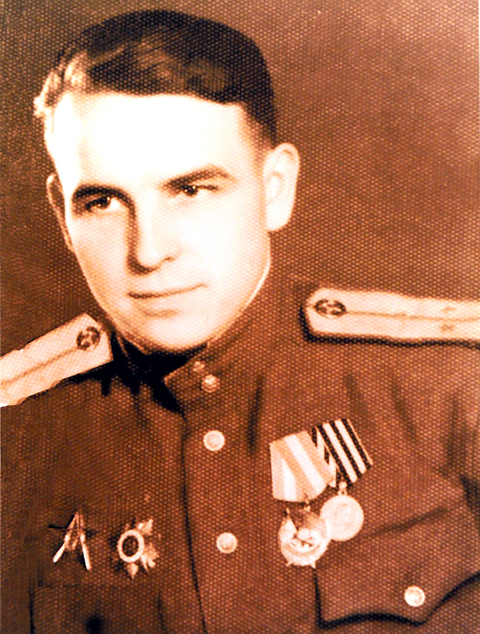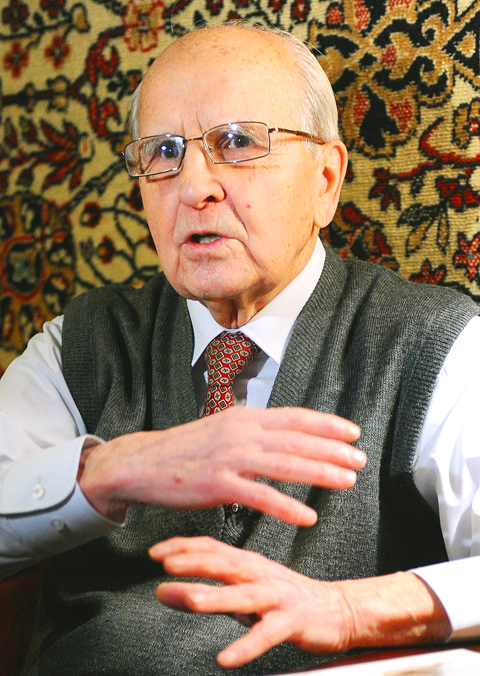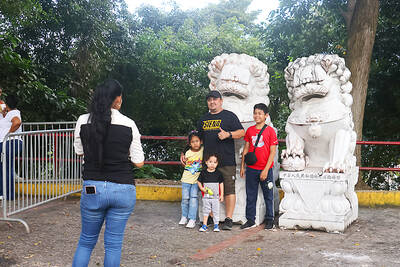Until the last, Ivan Martynushkin knew nothing of the horrors his unit would uncover when the Soviet army fought its way to the barbed wire fences of Auschwitz — Nazi Germany’s most infamous death camp.
Sixty-five years on, he is still haunted by what he saw — memories that have only grown more terrible as he learned the camp’s story.
Some 1.1 million people died at the camp between 1940 and 1945 — 1 million of them Jews from across Nazi-occupied Europe. Some died from overwork and starvation, but most were murdered in the gas chambers.

PHOTO: AFP
“I will remember those things until the end of my days,” the 86-year-old veteran, who headed a gunner unit of the Red Army’s 322nd rifle division that liberated Auschwitz, said in interview at his home in Moscow.
The sprightly, gray-haired veteran sat in his neat apartment surrounded by books and photographs, including one of him with Russian Prime Minister Vladimir Putin. A jacket pinned with war medals hung on the wall.
Martynushkin said it was only when he saw the camp’s barbed wires and his commander ordered the troops to hold their fire that he “guessed that this was some special military zone, that this was something else.”

PHOTO: AFP
For many veterans, the lack of shooting on that day — Jan. 27, 1945 — in the midst of the fiercest weeks of fighting, remains one of their most powerful impressions, Holocaust researcher Ilya Altman said.
Martynushkin recalled the ghostly quiet and acrid “ash-and smoke-filled” air at Auschwitz.
He had seen other Nazi prisoner camps, but as his unit moved along the perimeter of Auschwitz he was staggered.
“It was huge. It went on and on for kilometers,” he remembered. “We started to see groups of people when we reached the fence. They came up to us dressed in prison stripes, some had other clothes on top.”
“After being in such a hell, constantly threatened by death, they were worn, depleted people. The only thing to them were those eyes that reflected a kind of joy — of being freed, the joy that hell had ended and they remained alive,” he said.
As the Soviet troops closed in, 60,000 prisoners had been driven back behind the Nazi lines in a forced “death march” that would be remembered by the survivors as worse than all that had come earlier at the camp.
The few thousands left behind were thought too weak to march, but by some luck escaped being shot in the chaos of the rushed exodus.
Martynushkin turned 21 just days before arriving at Auschwitz, but by that time he had already spent three years at the front.
Desensitized by the scale of suffering he witnessed over the war, he did not realize the full horror of the death camp, he said.
It was only later, when the Nuremberg trials began, that he came to understand what had previously seemed unimaginable.
“Back then when we saw the ovens, our first thought was: ‘Oh well, so they are crematoriums. So people died and they didn’t bury them all,’” he said. “We didn’t know then that those ovens were specially built for the killing of people, to burn those who had been gassed, that kind of systematic killing.”
Auschwitz operated from 1940, a year after the German invasion of Poland. Its victims also included 85,000 non-Jewish Poles, 20,000 gypsies, 12,000 non-Jewish other European nationals and about 15,000 Soviet prisoners of war.
“It was unlike any other war. It was a war over the existence of entire peoples,” Martynushkin said. “We were able to see this plan at Auschwitz. Everyone was there, representatives of all the European nations.”
He was planning to travel to Poland with a handful of other surviving Soviet soldiers for the 65th anniversary tomorrow of the day they liberated Auschwitz.

Shamans in Peru on Monday gathered for an annual New Year’s ritual where they made predictions for the year to come, including illness for US President Donald Trump and the downfall of Venezuelan President Nicolas Maduro. “The United States should prepare itself because Donald Trump will fall seriously ill,” Juan de Dios Garcia proclaimed as he gathered with other shamans on a beach in southern Lima, dressed in traditional Andean ponchos and headdresses, and sprinkling flowers on the sand. The shamans carried large posters of world leaders, over which they crossed swords and burned incense, some of which they stomped on. In this

Near the entrance to the Panama Canal, a monument to China’s contributions to the interoceanic waterway was torn down on Saturday night by order of local authorities. The move comes as US President Donald Trump has made threats in the past few months to retake control of the canal, claiming Beijing has too much influence in its operations. In a surprising move that has been criticized by leaders in Panama and China, the mayor’s office of the locality of Arraijan ordered the demolition of the monument built in 2004 to symbolize friendship between the countries. The mayor’s office said in

‘TRUMP’S LONG GAME’: Minnesota Governor Tim Walz said that while fraud was a serious issue, the US president was politicizing it to defund programs for Minnesotans US President Donald Trump’s administration on Tuesday said it was auditing immigration cases involving US citizens of Somalian origin to detect fraud that could lead to denaturalization, or revocation of citizenship, while also announcing a freeze of childcare funds to Minnesota and demanding an audit of some daycare centers. “Under US law, if an individual procures citizenship on a fraudulent basis, that is grounds for denaturalization,” US Department of Homeland Security Assistant Secretary Tricia McLaughlin said in a statement. Denaturalization cases are rare and can take years. About 11 cases were pursued per year between 1990 and 2017, the Immigrant Legal Resource

‘RADICALLY DIFFERENT’: The Kremlin said no accord would be reached if the new deal with Kyiv’s input did not remain within the limits fixed by the US and Russia in August Ukrainian President Volodymyr Zelenskiy is to meet US President Donald Trump in Florida this weekend, but Russia on Friday accused him and his EU backers of seeking to “torpedo” a US-brokered plan to stop the fighting. Today’s meeting to discuss new peace proposals comes amidst Trump’s intensified efforts to broker an agreement on Europe’s worst conflict since World War II. The latest plan is a 20-point proposal that would freeze the war on its current front line, but open the door for Ukraine to pull back troops from the east, where demilitarized buffer zones could be created, according to details revealed by